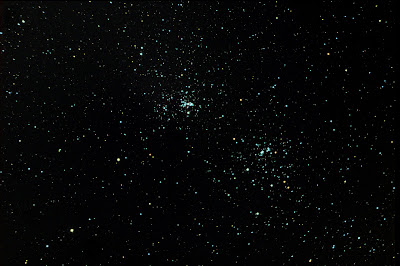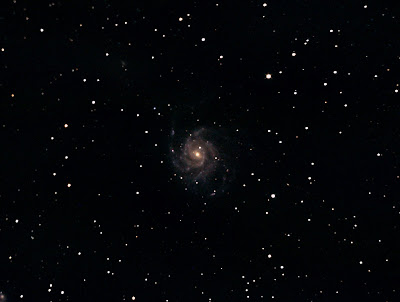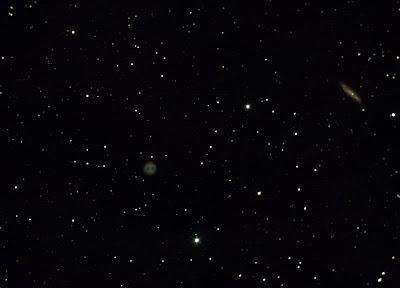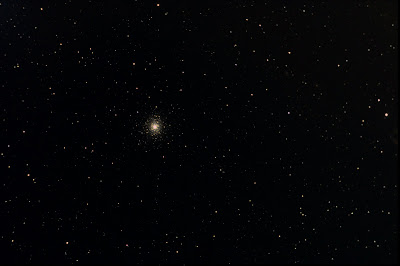In February, after several years of using uncooled, submegapixel cameras from Meade, I decided to upgrade to a cooled, multimegapixel camera. I chose the Orion Starshoot Pro, which offers a very large 6.1 megapixel CCD chip and TEC cooling.
As with any new piece of equipment there was the inevitable learning curve. The Starshoot Pro, not surprisingly, produces very large image files. Learning to properly stack and process images with the included Maxim DL Essentials software was also an adventure, though one well worth the effort. While considerably more effort is required to use the Maxim software to capture images, compared to Meade's simple Envisage, Maxim proved more useful in combining images taken over multiple nights.
Naturally, the new camera's arrival was followed by weeks of cloudy nights. In the two months that I have had the Starshoot Pro, there have only been about 10 reasonably clear nights. Nonetheless, that has been sufficient to produce a number of good images that clearly show the superior abilities of the Starshoot Pro.
Better still, with the DSI Pro no longer needed for imaging, I have been able to use it for guiding, attached to a 70mm refractor piggybacked on the 6" LXD-75. For the purpose of guiding, Meade's Envisage software works reasonably well, allowing me to take five minute sub-exposures (300 seconds). Longer sub-exposures appear to work better with the Starshoot Pro, and the size of the individual images mean that longer subs mean fewer images overall to stack.
The following are some of the better images captured over the last two months with the Starshoot Pro.
M42
Season permitting, this is perhaps inevitably the first target one wants to image with a new camera. This image is a stack of 20, 30-second sub-exposures. The Starshoot Pro's larger CCD chip also permits the inclusion of the entire nebula and associated star clusters in the camera's field of view. The DSI Pro would barely have captured the nebula itself with the same telescope.

Perseus Double Cluster
The famed Double Cluster in Perseus (NGC 869 & 884), provides another example of the benefits of a large CCD chip. With the Meade DSI, even with a .5 focal reducer bringing the 6" Newt's focal ratio down to f/2.5, I was unable to fit both clusters in the camera's field of view. This is not a problem with the Starshoot Pro, which easily capture both clusters at f/5.
This image comprises 10, 60-second sub-expsoures.

M101
The Pinwheel Galaxy in Ursa Major. This image comprises roughly two hours of 300-second subexposures taken over two nights (3/17/09 & 4/17/09).

M97 and M108
The Owl Nebula and irregular galaxy M108 appear in the same field of view thanks to the Starshoot Pro's large chip.

M92
A globular cluster in Hercules. This image was compose from six, 300-second sub-exposures.
The Whirlpool Galaxy in Canes Venatici. This images was composed from two and a half hours of 300 second sub-exposures taken on 3/12, 4/05, and 4/16.

M63
The Sunflower Galaxy. As usual, a considerable amount of exposure time is needed to bring out the faint details in the galaxy's spiral disk. This image is composed of a total of six hours of exposure time from 300-second sub-exposures taken on 3/17, 3/23, 3/24, 3/25, 3/30 and 4/16.

M81 & M82
Once again, the Starshoot Pro's large CCD chip permits both galaxies to fit easily within the same field of view. This image comprises about two hours of 300-second exposures taken on 3/5 and 3/20.



